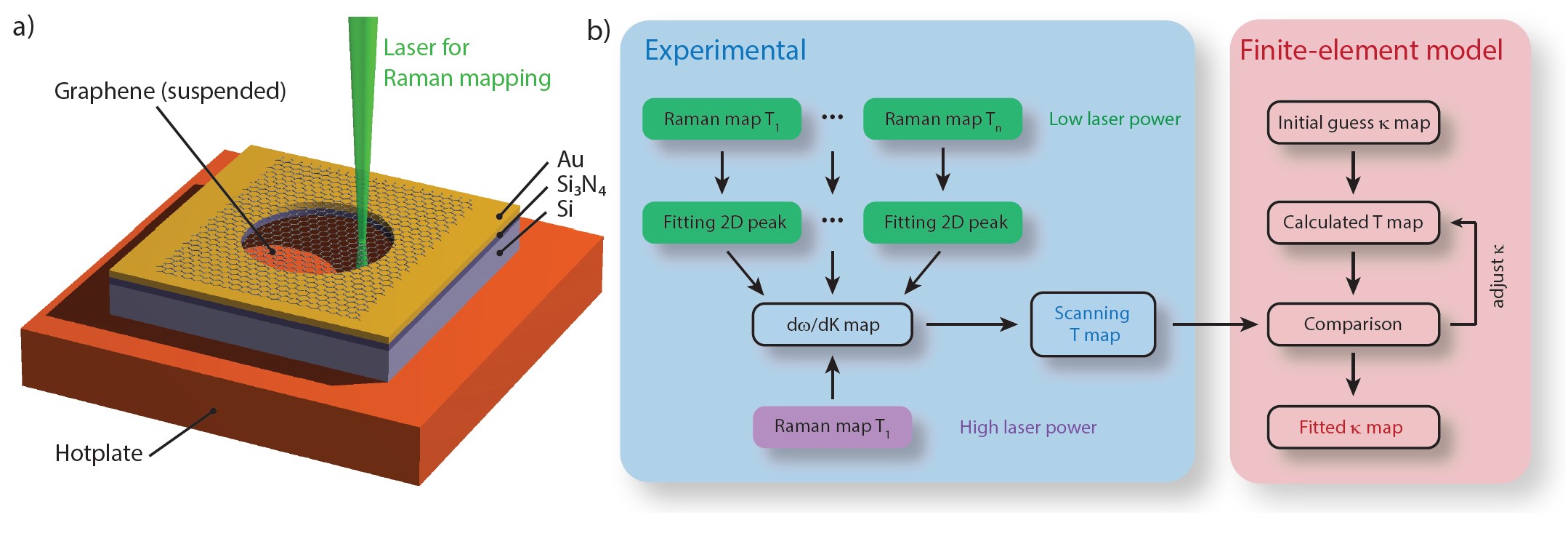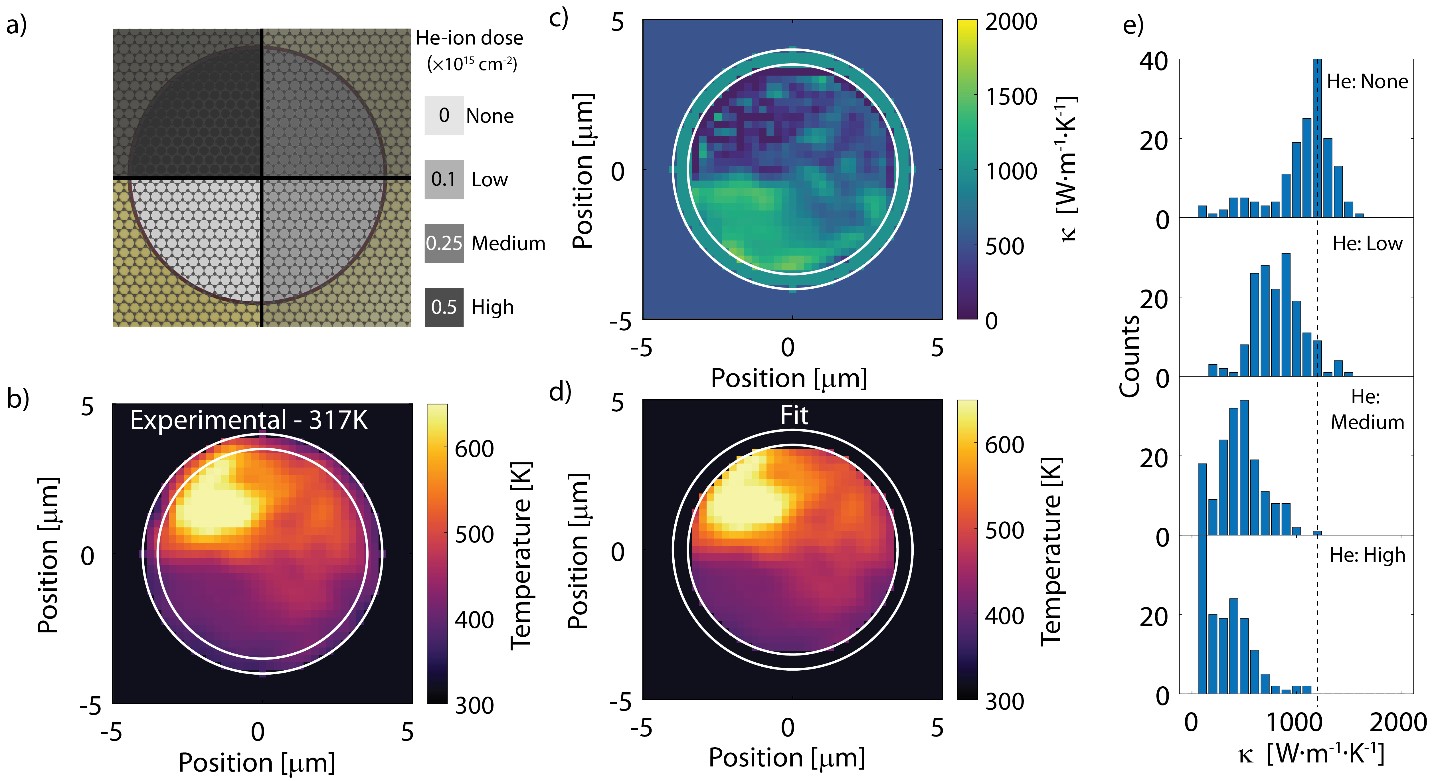Transport at Nanoscale Interfaces
Hybrid Nanoscale Interfaces
Spatially mapping thermal transport in graphene by an opto-thermal method
Here, we introduce an opto-thermal method that allows for two-dimensional mapping of thermal conductivity of suspended graphene membranes. The presented method relies on a combination of scanning μ-Raman spectroscopy with finite-element method (FEM) calculations. The workow for our approach is presented in Figure. 1. In the first experimental stage, a series of two-dimensional Raman spectroscopy maps are used to construct a temperature map of the membrane upon illumination. More specifically, Raman maps are recorded for various hotplate temperatures and at a low laser power. This series of maps is used to construct a calibration map of the Raman peak shifts with temperature. Then, another Raman map is recorded at high-laser-power, which, combined with the calibration map, is used to construct a temperature map of the membrane upon laser heating. The thermal conductivity is then iteratively adjusted, until the computed temperature map matches the experimental one.
 |
|
Figure 1. Experimental and Finite Element Method description. a) Schematic drawing of the suspended graphene membrane. b) Experimental workow to obtain a temperature map upon laser illumination and computational workow to fit the corresponding thermal conductivity map. |
As a demonstration of the capability of the presented method, we study the thermal conductivity of a graphene membrane that is exposed to He+-ions using focused ion beam lithography. As shown previously, He+-ions can be used to induce, in a controlled fashion, defects in suspended graphene membranes and other two-dimensional materials. We employ the procedure as presented in Figures 1 for the extraction of the temperature. Figure 2b)
presents the induced temperature map upon a 4 mW laser illumination. In this plot, the four quadrants are visible, with the lowest temperatures recorded in the (unexposed) lower left section of the membrane, and the highest one in the upper left (most exposed). This temperature map is used as input for the iterative FEM-based fitting procedure, resulting in the fitted thermal conductivity map in Figure 2c) and the corresponding fitted temperature map shown in Figure 2d). Figure 2e) presents a histogram of the thermal conductivity of each of the four quadrants. A steady decrease in average conductivity is observed, from ~1200 W/m/K for the no He+-ion irradiation, and ~300 W/m/K for the highest He+-ion dose.
 |
| Figure 2. |
As Raman spectroscopy is widely used in the two-dimensional materials community, our method is ideally suited for studying the thermal properties of other layered materials. Moreover, the working principle of the FEM method can easily be extended to more complex geometries or interfaces, in particular combined with alternative measurement techniques for providing a temperature map. Our method enables spatially resolving the thermal conductivity of atomically thin materials, a prerequisite for optimizing and engineering thermal stewardship in nanoscale devices.
Collaborators in Laboratory: Dr. Oliver Braun, Roman Furrer, Dr. Ivan Shorubalko, Prof. Michel Calame
External partners: Prof. Ilaria Zardo (University of Basel).
Funding: This work was supported by the EC H2020 FET Open project no. 767187 (QuIET). M.L.P. acknowledges funding by the EMPAPOSTDOCS-II program, which has received funding from the European Union's Horizon 2020 research and innovation program under the Marie Sk lodowska{Curie Grant Agreement no. 754364. M.L.P. also acknowledges funding from the Swiss National Science Foundation under the Spark grant no. 196795. I.Z. and M.C. acknowledge funding from the Swiss National Science Foundation under the Sinergia grant no. 189924 (Hydronics). I.Z. acknowledges funding form the European Research Council (ERC) under the European Union's Horizon 2020 research and innovation program (Grant Agreement 756365).
References
- Braun, O., Furrer, R., Butti, P. et al. Spatially mapping thermal transport in graphene by an opto-thermal method. npj 2D Mater. Appl. 6, 6 (2022). https://doi.org/10.1038/s41699-021-00277-2

Prof. Dr. Mickael Lucien Perrin
Group Leader Quantum Devices
Deputy Head of Laboratory
Phone: +41 58 765 4610